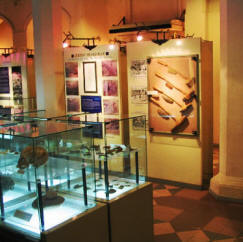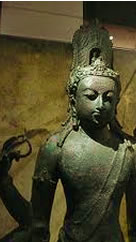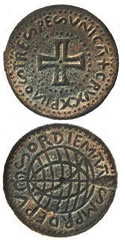National Museum ~ Places to Visit in
Kuala Lumpurm
KL Visitors Guide
HOME >
VISITORS
GUIDE >
PLACES TO
VISIT >
KL LAKE GARDENS AREA > NATIONAL MUSEUM
The National Museum or 'Muzium
Negara", is a palatial structure built in the style of Minangkabau
architecture, provides an interesting introduction to
the history and culture of Malaysia. Built in the style of a Rumah Gadang
and designed according to a compilation of aesthetic elements and
traditional Malay carving motifs.

The exhibits are
arranged in 4 galleries covering Early History, The Malay Kingdoms, The
Colonial Era and Malaysia Today Gallery.
Opened on 31st of August 1963,
the building has 26 concrete pillars, positioned to reflect the features of
a traditional Malay palace. The 26 pillars concept is based on the assembly
of 13 pillars to the east and 13 more to the west of the building, which
represents the 13 states of Malaysia. The Museum is built on the site of the
old Selangor Museum which was partially destroyed during an allied bombing
raid during WWII.

Two giant murals of Italian
glass mosaic line the front facade of the museum and portray highlights from
Malay history and culture. The mural on the west side of the building
illustrates the economic activities, traditional ceremonies and customs
inherited by the Malaysian society. The mural on the east side of the
building chronologically documents the significant events of Malayan history,
including the eminent Malacca Malay Sultanate, colonization and the
independence of Malaysia in 1957.

The Exhibits and Galleries
The exhibits are arranged in 4 galleries covering 2 floors which exhibit the
culture and natural history of Malaysia.
Early History Gallery - Permian Era / Prehistory Era / Proto History
Era
This gallery traces the discovery of stone tools from the Paleolithic Age,
up to the Hindu Buddhist era. It introduces you to the physical development
of Malaysia and its culture from prehistoric times until the Hindu Buddhist
era around 500 CE.
This gallery displays the
results of historical research and archaeological excavations. Exhibits
include Palaeolithic-era stone tools from 200,000 years ago, Neolithic
pottery, a replica of Perak Man skeleton (reckoned to be 10-11,000 years
old), a bronze Son Dong bell found near Muar, Johor which originated from
Vietnam in 150AD, and a 8th century Avalokitesvar statue.


The Malay Kingdoms Gallery - Early Trade routes / Early Malay
Kingdoms in the Peninsula / Early Malay Kingdom in the Archipelago / The
Malay Kingdom of Melaka / Malay Kingdoms: Contemporary and Successors of
Melaka
This gallery traces the development of early settlements, the emergence of
Malay kingdoms and sultanates, the coming of Islam and importance of Malacca
as a trading centre.
The Colonial Era Gallery - The Portuguese Era / The Dutch Era / The
British Era / The Japanese Occupation
This gallery covers the colonial era starting in 1511 with the Portuguese,
followed by the Dutch and then the British and their exploitation of raw
materials with the spice trade, tin mining, rubber and so on. The gallery
also records the Japanese occupation during World War Two.
Malaysia Today Gallery - Bringing us right up to date, the exhibits
in this gallery include items from the Malayan Emergency, the struggle for
independence, the formation of Malaysia, the political system and the
economic development of Malaysia.
Outdoor Exhibitions
The museum also has a number Outdoor exhibits such as examples of
transportation over the decades - a bullock cart, a gharry from Melaka, a
trishaw, an Austin Seven, an old Dennis fire engine, the first Proton Saga
(the first made-in-Malaysia car), and an early carriage from the Penang Hill
cable car which was used from 1923-1977. At the rear are old Malaysian motor
vehicles, including a fire engine and the Rolls Royce used by Malaysias
first prime minister.

There are also three
locomotives - A steam locomotive made in England by Kitson & Co. which was
in use from 1921 until 1969 on the East Coast line in Kelantan, a steam tank
engine (like Thomas!) made in England by W.G. Bagnall Ltd in 1927 which was
used for dock shunting in Singapore and Port Swettenham (Klang) until 1964
and a Class 22 Diesel locomotive made by English Electric Co. and introduced
to Malaysia in 1971 and used until 2002.
Also in the grounds of the museum is a traditional Malay building made of
cengal wood which dates from 1884 and used to stand in the compound of the
then Sultan of Terengganu until it was relocated to the museum in 1974.
Note
◊
Opening Hours - Open Daily 9:00 am - 6:00 pm
◊
Admission Charges:
Malaysians - Adult RM2 / Seniors and Disabled Persons: RM1
Foreigners - Adult: RM5 / Children aged 6-12 years: RM2
Children below 6
years old: Free
◊
For Updates Check-out Their > Website
◊ Some interesting themed exhibitions that are conducted from time to time
in the exhibition hall behind the main museum building.
◊ Photography and video recording is permitted in the galleries for private
purposes only, using hand-help equipment
◊ The museum is connected to National Planetarium through a walkway behind
the museum. From the planetarium, you can visit KL Bird Park (10 minutes
from planetarium by foot), KL National Mosque, and the Old Railway Station
as well.
Best Way to Visit - Take KL
City Tour
A private tour that allows you to see the major landmarks of the city and
its suburbs.
 PLACES & SIGHTSEEING ~ LAKE GARDENS AREA
PLACES & SIGHTSEEING ~ LAKE GARDENS AREA
PARLIAMENT HOUSE
NATIONAL MONUMENT
BUTTERFLY PARK
ORCHID & HIBISCUS GARDENS
KL BIRD PARK
ISLAMIC ARTS
MUSEUM NATIONAL
MOSQUE
OLD RAILWAY
STATION
NATIONAL
MUSEUM







